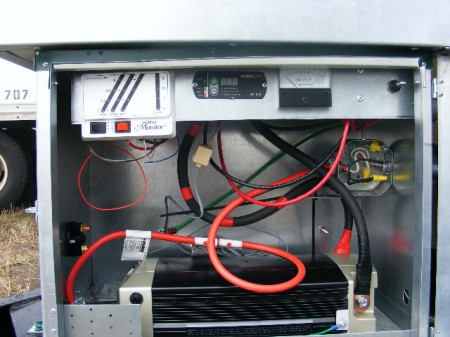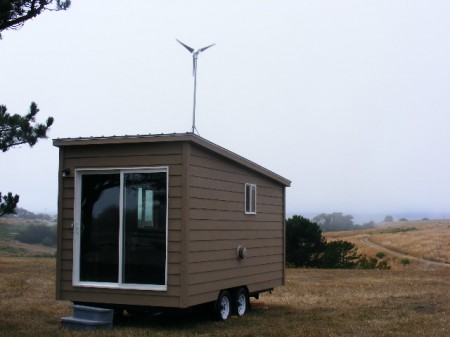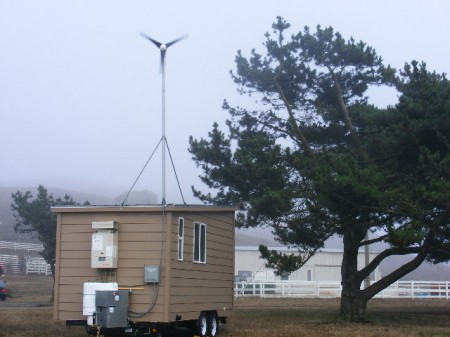Last month I ran a story about a delivery with Bill Kastinos from Tortoise Shell Homes to Chanslor Guest Ranch located 1 mile north of Bodega Bay. You can read the Tortoise Shell Camping Cube Delivery post here.
During the last month Bill has installed a wind generator on the camping cube, which will be used to power the cabins electrical needs. Initially, I thought they were going to be putting in solar panels and a back up generator as well.
Because the area has such regular winds on a daily basis, they have decided just to use the wind generator to keep the batteries charged up. I do not have the details and have not seen this in person yet, but hope to go out next week with Bill when he delivers the second camping cube and check it out in person. I will than fill you in with more details as far as how many batteries, watts, etc. are involved to make this off-grid system work.
If you have any questions, please post them in the comments below and I will get the details from Bill when I get together with him. Bill is in the process of developing a portable off-grid system that he will sell to tiny house individuals who want to run their homes off of the grid, so stay tuned for more information.


Copyright © 2009 Tiny House Blog
If you enjoyed this post, subscribe to our feed

Kent/Bill,
Does the turbine create too much noise or vibration inside the house? What kind of turbine did you choose? Any advice on shopping for turbines?
Thanks!
Michael
Lest anyone consider attaching any sort of wind turbine to a tiny house (or any size house for that matter), check out the pleadings of Mick Sagrillo and the final report of the only independent study ever undertaken that examines roof mounted micro-turbines, (google “Wind Doesn’t Work” and “Warwick Wind Trials”, respectfully) and/or check out this industry thread for more:
http://fieldlines.com/board/index.php?topic=144819.0
For clarification, Mr. Sagrillo is a huge wind PROponent, as am I – just not in urban areas and/or when attached to buildings. As sexy and alluring as wind is, we’re planning a solar installation for our off-grid urban homestead. Unfortunately, wind just doesn’t pay down-low and “in-town.”
Kai, Thank you for sharing the link to Sagrillo’s piece on rooftop wind turbines – an EXCELLENT read and ‘pleading’! It’s what EVERY person, tiny houser and all, should take 5 minutes to review, before spending hundreds and thousands of dollars on any foray into alternative power sources (solar being the proven ‘horse’ in the race thus far).
I would still consider having a wind turbine unit AND solar setup, someday, but now I feel I can understand, better, what to look for, what I can (and SHOULD be able to) expect!
Through history, with every revolutionary concept/movement there have been the attending ‘shysters and purveyors of snake oil’, some with merit, most with not an ounce.
Hey, it’s America, this is capitalism, I wave my flag proudly.
But we all have to be that much more cautious, do our own research and pursue the due diligence (repeatedly), in order to get the best ‘bang for our buck’.
Above all, be open to all ideas and pitches and read every ‘how to’ with a big lump of salt. 😉
Agree. This is a terrible design.
Truly awful.
Wind power = total nightmare.
Solar power = all day, every day,
And another thing about solar;
MPPT controllers = expensive, limiting and pointless.
PWM controllers = cheap as chips and totally versatile.
My first impression is… “That’s not a house. That’s a trailer that looks like a house.”
It’s on wheels, for crying out loud.
Michael, you are right, as this is set up as a camping unit. However, it does include everything a person would need to live, so yes, it is also considered a tiny house. It has a kitchen, bathroom and sleeping area, a person with bare essentials could live in one of these…
My concern is also about the vibration and potential structural damage that could result from a wind turbine mounted on a tiny house on wheels. Smaller turbines might have less potential for damage (or relocating the house!) in high winds, but they also don’t tend to return the energy investment that goes into manufacturing them.
(Scully: There’s a context you’re missing… Tiny houses are often built on a trailer base to get around draconian minimum sq. ft. requirements that make it illegal to build or live in a house less than 1500 sq ft in many communities. This is not the prettiest tiny house on wheels I’ve seen, in my opinion, but probably if you looked at its construction, you’d see the difference between a tiny house on wheels (THOW) and a trailer. In my understanding, from a design and construction perspective, a trailer is a vehicle first and a house second. A THOW is a house first, and incidentally on wheels. However, many people also build tiny houses not on wheels, and if that’s your interest I hope you’ll read further.)
Couple comments. I agree this is a spartan looking house, the purpose was to have it disappear on the hilltop, which because of its coloring and shape, it does. Chanslor Ranch is also Sonoma Wetlands, and they want to preserve the natural look of the area. Our second delivery to Chanslor Ranch will be our conventional Galapagos, to be parked down lower around the lake.
Two, these houses are custom homes, not RVs. They are homes in every respect, but being under 120sq ft, and under 8ft wide and 40ft long (RV), it allows some “creativity” in where they can be parked or lived in. They are extremely low maintenance with commercial steel roofs, and hardee silica cedar mill siding. The only RV component in the interior, is the RV toilet (future compost) and RV cooktop. It uses conventional tankless hot water heater, propane furnace, Moen faucets, S/S sink, heavy interior plywood finish, 1 1/8in t&g plywood floor glued and screwed, and a commercial Codding Steel Frame Solutions frame. Three. The wind turbine is extremely quiet, even in high winds. It is a Marine Model for durability (Air X), and uses a unique dampening system to isolate vibration from the house. It is an 1800 watt system, and will continue for 8-15 hours without wind. A rare event not to have wind that close to the Ocean. More to come on that, as Kent said.
Hey Kent!
A few questions for when you head out there, if you’d look into them it would be great.
1. cost and ouput of wind turbine?
2. how much power does it provide?
3. What type of batteries and how many?
4. How long are the batteries expected to last?
5. cost of getting the electrical system done?
Hi Ryan, yes I will get those questions answered from Bill when I am out there. I am new to this but would really like to learn more about it. Thanks for your interest…Kent
We use a land-based model of the Air X at our float cabin. It is mounted on the float next to the cabin. I am not sure about how much vibration there is, but the sound is more of a whoosing and not all that loud. We use it as a winter backup because of the lack of sun, but it doesn’t provide us with enough power to depend on. You can watch a video I did on YouTube http://www.youtube.com/watch?v=XVKptyv9iI8
We are looking into thermoelectic power generation from our wood stove. That is a power source we have going all winter long. – Margy
Thanks Margy for your input into this discussion, it is good to here from someone with experience with these, also the video is a neat way to experience the sound of the turbine. I hope to video tape the turbine when I am out next week also.
Correction, our marine unit is an Air Breeze 200w. The land unit is an Air X 400w. We chose marine units for both the wind turbine and inverter, because they are built to handle abuse and the salt air.
Bill Kastrinos
Tortoise Shell Home
Well, I’ve certainly lived in less comfortable circumstances than a tiny house on wheels, alas.
It looks like Margy’s wind generator would benefit from being higher up and if possible further away from the cabin. If you notice in the video the wind generator keeps changing speed and direction which is probably because it’s running in turbulent air. Running in less turbulant air would increase the Watt Hours output.
But of course, some wind power is better than none.
Just my 2 cents. 🙂
this is cool I want to know more as I am a carpenter and can do a lot of the work myself .but I have no imagination and feel like I must work off of plans, Robert
Bill, thanks for all the details on the turbine. Looks like a winner.
For anyone that’s interested here’s a link to the manufacturer’s website: http://www.windenergy.com/
It looks like they don’t sell direct to the public but do provide a simple map search on their website for finding retailers.
P.S. Here’s the product detail page for the AIR Breeze and AIR X wind turbines in case you were looking for the specifications:
http://www.windenergy.com/products/air.htm
Thanks Michael for getting those links and information…Kent
I think the wind turbine is a nice design for the tiny house. I am working on a tiny house as well, and would love to see the list of components that Bill used for the wind turbine/battery set up.
I have been researching solar and wind set ups for my tiny house. They will need to be portable, since the house will be moved from time to time. I would like a dual system, both solar and wind since I do not know what the local climates will be like where I am going.
The kits I have found so far have been low power set ups, and might not meet my power needs. I have looked at several solar sites, but many seem to be geared to residential houses and not portable houses. Trying to figure out all the components needed for a system has been a challenge so far.
Keep up the good work Kent and Bill.
Thanks for the suggestions Tim. We are limited to location because of the float on which our cabin sits. Shore based wouldn’t be very easy because of float movement, besides the length of cable needed would cause quite a bit of loss I would think.
But that is not the only reason for the changes in wind direction. We live in a bay right next to a high rock wall that causes the wind to bounce around in all directions. Even if the generator was higher I think the wall would cause problems. And you are right, some generation is better than none. – Margy
Hi,
This is awesome. I have been thinking about it as a viable energy source for my planned small house on wheels. I realize that it will make all the difference where the house is located though. I like the idea of having a energy-generating package for when you move locations where one might be better for wind and the other better for sun, etc.
Another thought that came to mind. Would the turbine on the house be a lightning risk? I like the idea of it being all together, but wonder at the risk for a little house that will go up in flames pretty fast.
Kim
Just a note of caution, we are putting these houses in a very unique location wind wise. I can’t ever recall being in an area that has such consistent wind. Sharon and I did stay out there the other night. The wind stopped at 8pm, the turbine didn’t turn until 10am the next morning (rare). The frig continued its cycling on and off, we used lights, tool charger, power tools, showers (tankless hot water heater uses a little electricity), and at 10am the system was still at 11.5 volts, and the frig had made ice cubes and continued to work. Then the turbine started generating again. So we were pretty happy, 14 hours on two 6v batteries. There are Lithium Iron batteries out there that would take this unit for weeks with no wind. Expensive though.
Couple comments on posts. The apparent speeding up and slowing down of the blades in the youtube video are a function of the regulator loading and unloading the blades. And the controller, unlike a solar controller, will “try to find a place” for electricity being generated, even if the batteries are full, rather than just on and off. For instance, if the batteries are full, and you turn on a light, the controller will compensate, so you are running off excess wind charging rather than backup battery. Bill Kastrinos Tortoise Shell Home
Thanks Bill for the additional information as it has not worked for me to come out and see the system this week as I had originally hoped to. Hopefully next week you will have the other unit ready to go and I can join you than…Kent
PS Forgot to comment on Lightning. All houses should have a lightning rod, but few do. We take our chances. Whether little house or big, lightning can take you out. But extremely rare. A very simple ground strap could go from the tower to a ground rod if your house is fixed, maybe a chain that drags on the ground if you are mobile.
Bill Kastrinos
Good design. How much rated power of this wind turbine. It will get more power if the tower is higher than now.
This is just my style
Are the wind and solar powers compact enough to pick up and go whenever you want to move the tiny house? Where would I get the homemade plans for both wind and solar powers to make on our own?
Thank you
Linda
strong
Linda,
The off grid units break down and travel with the tiny house.
We do not offer plans.
Thank you.
Bill Kastrinos
Tortoise Shell Home LLC
http://www.instructables.com
for wind turbines and solar power
wow, this looks so great, I don’t suppose you have an Australian distributor? Just that I’m in country Victoria and would love to get one of these…
Wind generators are the best since they do not cause any pollution at all. ..
<a href="Take a look at all of the freshest write-up at our own homepage
http://www.caramoantourpackage.com/caramoan-hotels/
Hello there! This is the third time visiting now and I just wanted to
say I truley enjoy looking at your blogging site. I decided to bookmark it
at digg.com with the title: First Wind Powered Tiny House?
and your Web address: http://tinyhouseblog.
com/stick-built/first-wind-powered-tiny-house/.
I hope this is okay with you, I’m making an attempt to give your wonderful blog a bit more exposure. Be back soon.
I think as an average “person” what we need is someone to figure out and print up a simple and complete set of just what to buy for how much out put we simpler people need. not just a diy but the whole shebang. what size and how many batteries, the type of inverter for how much juice you’ll need.etc. all this watts and amps stuff just makes my head swim.Lamar Alexander has books out, (which i just bought the ebook from) and he explains well, it’s just my brain does not comprehend well. I’m more carpenter than electrician. I just want simple like: inverter with 300,600, 1000 watts. Battries 4 deepcycle that has so much capacity the xyz brand is recomended. things like that. You smart guys and gals have a real understanding of this and i can not get my head around it at all. If you have a small fridg, some led lights, a microwave or some such then you need XYZ to run it all. i know it can vary from person to person, but surely there has to be help for a small one size fits this or a medium size will work for that, see what i mean?
clicking on the link to your Snapper Home on website consistently leads me to this page about the wind powered house?
Where can I find the link about for the 8×28 Snapper Tiny House?
Chanslor Guest Ranch is about a mile up the coast from me and directly across from Salmon Creek Beach in Bodega Bay. This is a perfect site for this little structure. I’m anxious to see how the wind turbine functions out here. It’s also a good test for code issues as Sonoma County is a bit all over the map on this issue . . . Thanks for this post!
It seems to me that a vertical turbine would be less susceptible to changes in wind direction.